#BioTechnology
Explore tagged Tumblr posts
Text
By using antibodies from a human donor with a self-induced hyper-immunity to snake venom, scientists have developed the most broadly effective antivenom to date, which is protective against the likes of the black mamba, king cobra, and tiger snakes in mouse trials. Described in the journal Cell, the antivenom combines protective antibodies and a small molecule inhibitor and opens a path toward a universal antiserum.
Continue Reading.
37K notes
·
View notes
Text
"If you're hoping that reef-restoring coral larvae will settle down in damaged reefs, you can't just sit around and wait for it to happen. You have to get out there and entice the larvae, which is exactly what a new algae-based gel is designed to do.
While we may think of coral reefs' "skeletons" as being composed solely of calcium carbonate produced by coral polyps, much of the material is in fact generated by what are known as crustose coralline algae.
Along with contributing greatly to the structural integrity of reefs, the algae-produced calcium carbonate also serves as a home to planktonic coral larvae. Once those formerly free-swimming organisms settle in and become polyps, they start producing reef-building calcium of their own.
It's a good arrangement for the coral, but it also benefits the algae.
Not only does the reef itself provide the algae with protection from the elements, the coral polyps also emit ammonia which the algae feed upon. It is therefore in the algae's best interest to entice any coral larvae that may be swimming past in the water column. In order to do so, the algae release metabolite chemicals that attract the larvae.
Led by Dr. Daniel Wangpraseurt, scientists at UC San Diego's Scripps Institution of Oceanography have now incorporated those metabolites into a gel that can be applied to degraded coral reefs. Called SNAP-X, the substance reportedly boosts coral larval settlement by up to 20 times as compared to untreated surfaces.
If the algae metabolites were just applied to the coral on their own, they would soon dissipate in the water, leaving the coral larvae unable to follow them to their source. For that reason, the researchers started by encasing the chemical molecules in durable silica nanoparticles. Those particles were then suspended within a biocompatible liquid blend of gelatin methacrylate and polyethylene glycol diacrylate.
When that liquid is sprayed or painted onto a surface – such as a piece of dead coral – then exposed to ultraviolet light, it polymerizes into a hydrogel form. That gel is capable of clinging to the surface for up to one month while immersed in flowing water, gradually releasing its larvae-attracting nanoparticles as it does so.
Initial lab tests showed that application of SNAP-X resulted in a six-fold increase in larval settlement. Subsequent tests that more accurately simulated the water flow on coral reefs, however, produced the 20-times figure.
It should be noted that all of the tests conducted so far have involved a single type of coral, but Wangpraseurt believes the technology should work on other species with a few tweaks.
"I think this material is a breakthrough that can hopefully make a big contribution to coral restoration," he says. "Biomedical scientists have spent a lot of time developing nanomaterials as drug carriers, and here we were able to apply some of that knowledge to marine restoration."
A paper on the research was recently published in the journal Trends in Biotechnology."
-via New Atlas, May 26, 2025
#coral#conservation#ocean#marine biology#ecosystem#ecosystem restoration#ecology#marine science#marine life#coral reef#science news#tidalpunk#biotechnology#good news#hope
877 notes
·
View notes
Text

CRISPR was already on thin fucking ice as a serious name for a biotech technique and now they made up CRISPY-BRED are you joking
5K notes
·
View notes
Text
Dandelion News - March 15-21
Like these weekly compilations? Tip me at $kaybarr1735 or check out my Dandelion Doodles! This month’s doodles, like every third month, will be free to the public, so take a look!
1. Zoo 'overjoyed' as lion cubs increase pride to 10
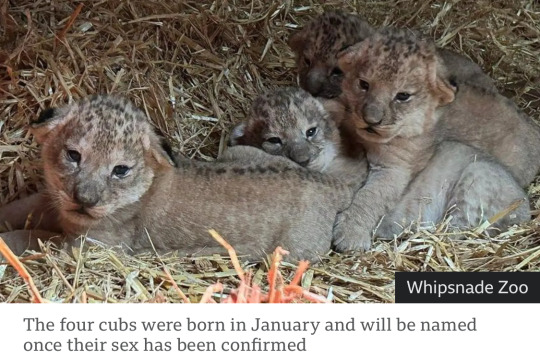
“The litter of rare northern African lions was the second batch to be born recently at Whipsnade Zoo in Bedfordshire, after three arrived in November. […] "The youngsters will grow up side-by-side with their half-siblings, and I'm sure they'll love having an abundance of playmates."”
2. Ohio Appeals Court Rules Trans Care Is Healthcare, Strikes Down Ban For Trans Youth

“The ruling rested on two key findings: first, that gender-affirming care constitutes legitimate medical treatment, and second, that parents have the constitutional right to make healthcare decisions for their children.”
3. Oystercatcher Recovery Campaign Offers a Rare Success Story about Shorebird Conservation
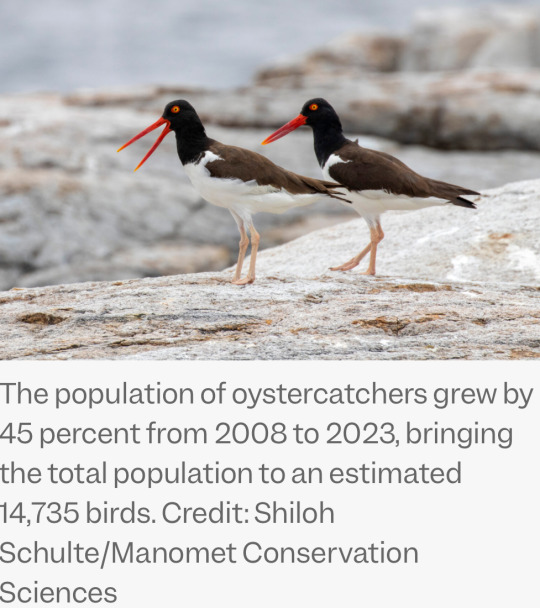
“Fifteen years of coordinated conservation efforts have produced a significant recovery in the U.S. population of the American oystercatcher[….] Schulte predicted that the protection efforts will survive [federal funding cuts] because of the large number of non-federal partners involved.”
4. Fish-tracking robot aims to make fishing more sustainable in developing nations

“A solar-powered, transparent [robot] that can roam the waters autonomously for five days at a stretch, counting fish [… can help fishers] avoid the overfishing [… and] mean less fuel consumed by boats searching for schools of fish, and less degradation of nets due to trawling where there are no fish.”
5. Zoologist Rediscovers Grasshopper Species Believed Extinct
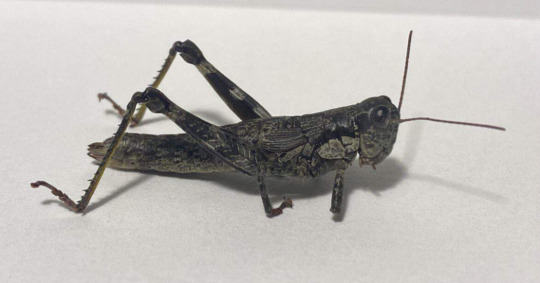
“[… T]he Appalachian grasshopper […] camouflages with its surroundings—perhaps part of the reason people haven’t seen it [since 1946]. [… A zoologist] had seen some reports on iNaturalist that he thought could have been the species[, …] and after surveying several locations, he found a female.”
6. Scaling agroforestry can support fisheries, local food production and cultural practices
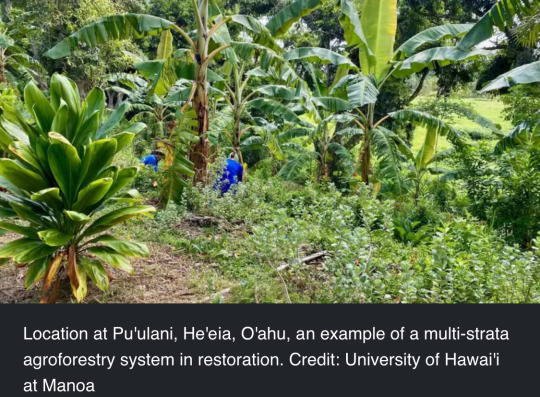
“The research found that combining native forest protection (100,000 acres) with transitioning suitable fallow agricultural land to agroforestry (400,000 acres) could [reduce] erosion and boosting nearshore food production by almost 100,000 meals per year[….]”
7. A cell pulls off one of the 'Holy Grails' of biotechnology
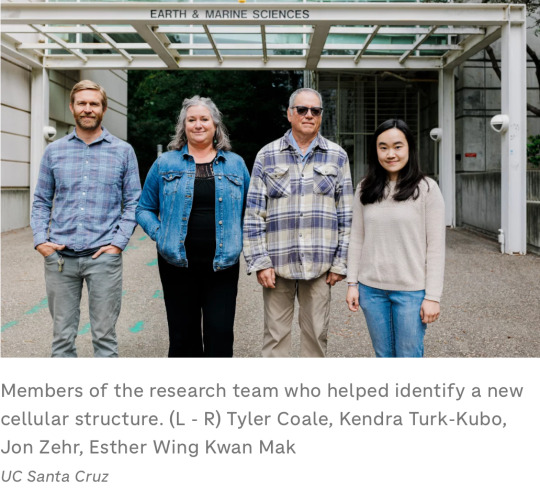
“[… A] single-celled alga with a nucleus [… can conduct] a chemical conversion reaction that helps create some of the essential building blocks of life. […] One day, Capone says the nitroplast could be introduced to crops to allow them to convert their own nitrogen without relying on external fertilizer.”
8. FERC: Solar + wind set for a strong 3-year run despite Trump’s sabotage

“Solar accounted for 68.2% of all new generating capacity placed into service in January – more than double the solar capacity added a year earlier (1,176 MW). […] Around 30% of US solar capacity is in small-scale (e.g., rooftop) systems that are not reflected in FERC’s data.”
9. As ghost junk haunts the sea, ‘mermaids’ are fighting back

“Just two days after completing the training, Diana Garcia, one of the Sirenas, helped remove nearly 900 kilograms (2,000 pounds) of [abandoned] ghost gear and debris in the waters near her community[….]”
10. A Nest-Protecting Program Pays Off for Alabama’s Snowy Plovers

“Over the past two breeding seasons, 18 Snowy Plover chicks fledged—a major turnaround after five years of almost no chick survival. [… The team made] a concerted effort to educate the public about the need to give the birds space[, … and] people have not directly caused plover losses in Alabama recently[….]”
March 8-14 news here | (all credit for images and written material can be found at the source linked; I don’t claim credit for anything but curating.)
#hopepunk#good news#nature#zoo#lion#baby animals#us politics#ohio#trans rights#trans healthcare#healthcare#birds#conservation#fishing#sustainability#grasshopper#insect#extinction#inaturalist#agroforestry#hawai'i#hawaii#biotechnology#algae#symbiosis#nitrogen fixation#solar#solar energy#solar power#endangered species
742 notes
·
View notes
Text



"Meet Romulus and Remus—the first animals ever resurrected from extinction. The dire wolf, lost to history over 10,000 years ago, has returned. Reborn on October 1, 2024, these remarkable pups were brought back to life using ancient DNA extracted from fossilized remains.
Watch the pups grow up and catch exclusive videos on our YouTube channel. "
Via Colossal Biosciences®
324 notes
·
View notes
Note
hi have you seen the very recent video by veritasium? i know you're most likely not the most qualified expert but i'd like to hear what you thought/ what interesting things you might add about it!
https://www.youtube.com/watch?v=P_fHJIYENdI
(easy link)
awesome video that shows off one of the best uses for AI computation.
i don't have much to add, except that the video makes it kind of easy to walk away thinking AlphaFold is a perfect program, which is not true. its usefulness is very limited by its accuracy (90% still leaves a lot of room for error!) and the way it topologically builds the protein structure. it's also worth noting that protein structure is not always rigidly defined! many proteins in your body need to be disordered to function:

if you're looking for a more silly application for science though (which i assume most people following this blog are), @hellsite-proteins is a gimmick blog that runs posts through AlphaFold, the exact program talked about in this video. give them a look!
387 notes
·
View notes
Text
"The substances behind the slimy strings from okra and the gel from fenugreek seeds could trap microplastics better than a commonly used synthetic polymer.
Texas researchers proposed in 2022 using these sticky natural polymers to clean up water. Now, they’ve found that okra and/or fenugreek extracts attracted and removed up to 90% of microplastics from ocean water, freshwater, and groundwater.
With funding from the U.S. Department of Energy, Rajani Srinivasan and colleagues at Tarleton State University found that the plant-based polymers from okra, fenugreek, and tamarind stick to microplastics, clumping together and sinking for easy separation from water.
In this next stage of the research, they have optimized the process for okra and fenugreek extracts and tested results in a variety of types of water.
To extract the sticky plant polymers, the team soaked sliced okra pods and blended fenugreek seeds in separate containers of water overnight. Then, researchers removed the dissolved extracts from each solution and dried them into powders.
Analyses published in the American Chemical Society journal showed that the powdered extracts contained polysaccharides, which are natural polymers. Initial tests in pure water spiked with microplastics showed that:
One gram of either powder in a quart (one liter) of water trapped microplastics the most effectively.
Dried okra and fenugreek extracts removed 67% and 93%, respectively, of the plastic in an hour.
A mixture of equal parts okra and fenugreek powder reached maximum removal efficiency (70%) within 30 minutes.
The natural polymers performed significantly better than the synthetic, commercially available polyacrylamide polymer used in wastewater treatment.
Then the researchers tested the plant extracts on real microplastic-polluted water. They collected samples from waterbodies around Texas and brought them to the lab. The plant extract removal efficiency changed depending on the original water source.
Okra worked best in ocean water (80%), fenugreek in groundwater (80-90%), and the 1:1 combination of okra and fenugreek in freshwater (77%).
The researchers hypothesize that the natural polymers had different efficiencies because each water sample had different types, sizes and shapes of microplastics.
Polyacrylamide, which is currently used to remove contaminants during wastewater treatment, has low toxicity, but its precursor acrylamide is considered toxic. Okra and fenugreek extracts could serve as biodegradable and nontoxic alternatives.
“Utilizing these plant-based extracts in water treatment will remove microplastics and other pollutants without introducing additional toxic substances to the treated water,” said Srinivasan in a media release, “thus reducing long-term health risks to the population.”
She had previously studied the use of food-grade plant extracts as non-toxic flocculants to remove textile-based pollutants from wastewater and thought, ‘Why not try microplastics?’"
-via Good News Network, May 10, 2025
#microplastics#plastic#plastic pollution#okra#fenugreek#biotechnology#solarpunk#water pollution#pollution#united states#north america#texas#good news#hope
209 notes
·
View notes
Text
Utik
The utik (yoo-tik) are a sophont species the rakii came in contact with when they first landed on Ra'hah, their second largest moon orbiting Rek. The utik were actually the first to even set foot onto it, as they had no other choice. After suffering massive damage to their ship, the utik were forced to land on the lunar surface and hope to survive or await help. Years later, the rakii show up, which started an a long, chaotic process of attempt of communication and debating ownership.
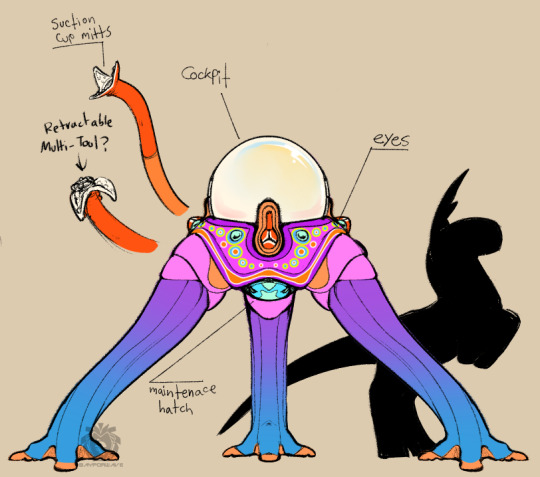
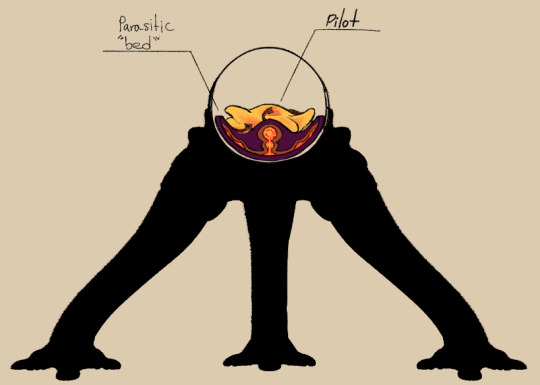
The bodies of the utik are actually not their true bodies. The actual sophont lies within the pearly cased cockpit. Utik like the Olac bio-mechs, mastered the technical art of bio-technology, having started on a very hot and humid planet. While unlike the Olac who switched to bio-technology as a means to evade a debilitating disease, the utik mastered it for years, working off various symbiotic organisms. Their mech suits, or cyborg bodies you could say are symbiotic, as after their nervous and circulatory systems are linked, the pilot has full control of the suit, having it feed off waste material from the pilot. The suit then takes the waste, replenishes it, mixes it's own formula into it and feeds it back to the pilot. Like a plant, it gets a lot of energy off light and other forms of UV Retaining it for hours. These suits are suitable (ha) for open space, and lunar terran for a limited time. However proper measures are made to keep the suits tidy from "space dust" so no one goes out "naked" and risk exterior damage.
(quick sketch of utik 'pooters n screens. NOT ENTIRELY FINALIZED)
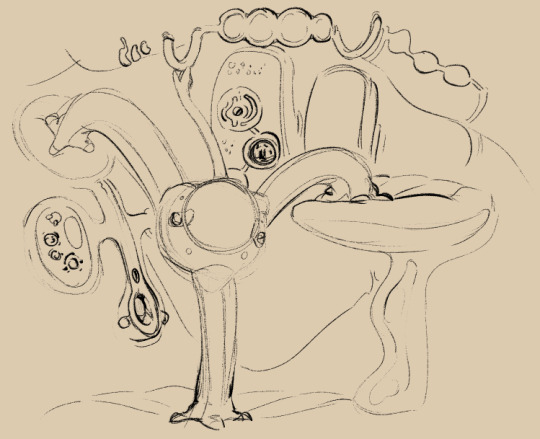
However, this isn't their true form. At least they didn't start off like this.
Way before, after they reached the ultimate feat in their development, their star was noticeably suffering, as it was predicted to eventually turn into black hole. While they had years 'till then, there wasn't enough time to perfect their original forms for the long-term space travel. So. as best they could, they learned to carefully strip and reduce themselves to nothing more than squishy muscle and brain matter, beforehand creating living space suits and sleeper pods to maintain what's left. Several ships shot into space just in time before their star went dark and each ship jumped in different directions hoping to find and terraform a new world. This group of utik weren't so lucky, as said before.
Now for the first half of the year, rakii and utik were on some tense terms. A lot of internal debates on who gets the moon. While utik were capable of defense, they weren't in a great position to, and the rakii weren't sure how to proceed with their first extraterrestrial contact. (Non-religious turned contact I'd guess???) UNTIL, one day it was brought ahead that, the utik secrete an anti-radiation slime. Something they came with naturally, just cranked to 10.
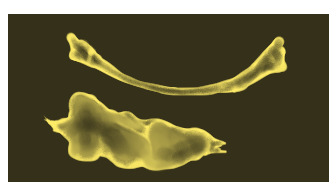
At first, the rakii thought to use this fluid as an applicable substance similar to sun-block, required to apply pre-spaceflight. However, it was revealed that they are extremely allergic to it. So skin-contact was a big no.
(Unfortunate rakii subject applying utik-based lotion. Results: swelling in skin, which can further cause blisters and splits)
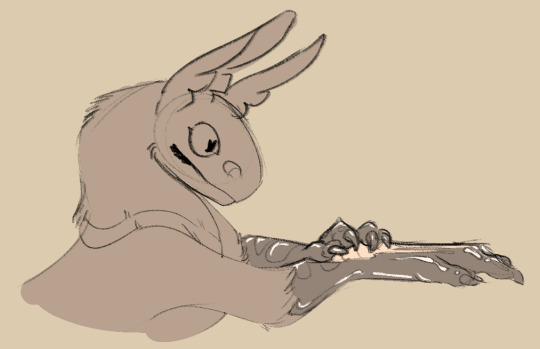
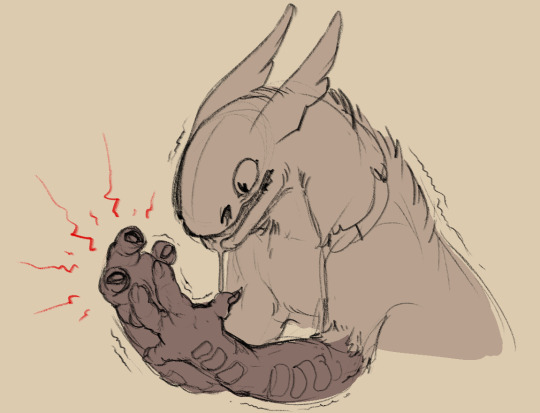
After several trials, they came to a conclusion of using it as a gel layering in space suits, capable of absorbing radiation and protecting the wearer.
This discovery brought up a plan and a deal. It was agreed, rakii and utik would share the moon, making their first ever alliance, in exchange the utik would allow the rakii to harvest this anti-radiation goop off them, of course while exchanging knowledge, and resources.
520 notes
·
View notes
Text
From Cameron D. E. et al. (2014), A brief history of synthetic biology: a selection of simple machines that can be built inside living organisms by using gene expression and regulation as parts.
For the sake of illustration, the purpose of all these machines is to start the expression of Green Fluorescent Protein (GFP), which does exactly what the name suggests.
(Note: italics are used for the name of genes, and not for the proteins they encode. The gene GFP encodes the protein GFP.)

Toggle switch. Two genes, lacI and cI, repress each other's transcription (repression is represented by the T-shaped end of a line, an transcription by the bent arrow), so that exactly one of each can be expressed at any given time. This occurs because the expression of each gene is a repressor protein that binds to the control region of the other, making transcription impossible. Since GFP is consecutive to cI, the former is only expressed together with the latter. The enzyme called IPTG deactivates the repressor lacI, starting the transcription of cI and therefore GFP: the fluorescence switches on, and lacI remains inactive because cI is repressing it. If heat is applied, then cI is deactivated: lacI is expressed, lacI deactivates cI, and the fluorescence switches off.
Purpose: gene expression that can be cleanly switched on and off by simple inputs.
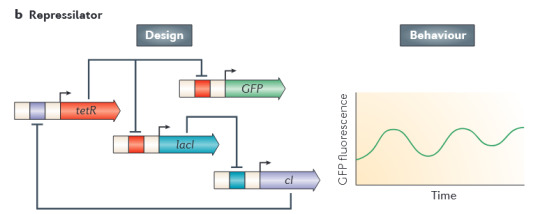
Repressilator. A circuit in which lacI represses cI, cI represses tetR, and tetR represses both lacI and GFP. In each cell, a signal of repression travels through the whole circuit: the repression of tetR allows the expression of lacI, which represses cI, which reactivates tetR, and vice versa. The expression of GFP, and therefore the cell fluorescence, fluctuates over time in a regular cycle.
Purpose: gene expression that cycles over time.

Autoregulatory circuit. The gene tetR, concatenated to GFP, represses its own expression. Whenever too much tetR and GFP are produced, the expression regulates itself down, so that in a large population there is much less variation in fluorescence: all cells converge to a moderate value. (remember?)
Purpose: gene expression that is kept moderated in a population of cells.

Modular riboregulator. Control acting later in gene expression: not on DNA -> RNA transcription, but on RNA -> protein translation. Transcribed GFP is connected to a sequence that inhibits translation by folding over and preventing the ribosome from attaching to the RNA. A separated activator RNA binds to this sequence and prevents it from preventing translation.
Purpose: a second tier of control over gene expression.

Two-input AND gate. Logic gates with genes! Expression of GFP requires a promoter encoded in T7, which in turn is only expressed in the presence of arabinose. However, the promoter only works if it's modified by by RNA produced by supO, which is only expressed in the presence of salicylate. Therefore, GFP is only produced if both arabinose and salicylate are present at the same time.
Purpose: protein synthesis that only occurs if multiple conditions are verified.

Multicellular pattern formation. This one is meant to be used in large cell populations. The gene luxI in the "sender cell" encodes an enzyme that produces AHL, a signal molecule. This molecule may bind to LuxR receptors in the "receiver cells". LuxR binding AHL activates the expression of cI, which stops the expression of lacI, which stops the expression of GFP. However, lacI can also be directly activated by binding AHL, so that only an intermediate concentration of AHL results in producing the fluorescent protein. By adjusting the sensitivity of LuxR, GFP and RFP can be produced selectively at different concentrations of AHL, and therefore at different distances from the sender cell.
Purpose: spatial control of gene expression.

Relaxation oscillator. Similar in concept and purpose to the repressilator, but the cycle it creates is more stable and regular. araC activates GFP, lacI, and itself; lacI represses GFP, araC, and itself.

Recombinase-based logic. GFP is flanked by sequences that can be inverted by the recombinase enzymes Rec1 and Rec2 (Rec1 inverts whatever is between the blue boxes, and Rec2 what's between the orange boxes, respectively). Arranging the markers around GFP in different ways allows the construction of different logic gates. In the case of the AND gate, the transcription in the blue region is going in the wrong direction, and GFP is also backward; both recombinases must be active for GFP to be expressed. In the case of the OR gate, transcription begins in both the blue and the orange region, but goes in the wrong direction in both; it's sufficient for either to be inverted by one recombinase to express GFP. In the case of the NOR gate, transcription already proceeds well, as long as both recombinases are absent.
Purpose: construction of arbitrarly logical circuits; very precise conditional control of gene expression.

Edge-detection circuit. A modification of the quorum-sensing system used for the multicellular pattern. The cell colony is exposed to light, half-covered by an opaque mask. Cells in the dark express the luxI gene, producing the AHL signal, as well as cI; the sensor that activates the expression of these two genes turns off in the light. The gene lacZ leads to the production of a black pigment; it is activated by LuxR (the receptor of AHL), and repressed by cI. Therefore, the black pigment is only produced in cells exposed to light (no expression of cI) which are adjacent cells in the dark (low-sensitivity LuxR receiving AHL from neighbors).
Purpose: mark edges between areas with different conditions.
#biology#stuff i like#biotechnology#papers#longpost#i feel you could make a game simulating this stuff
83 notes
·
View notes
Text

Reminder: you can't kill them in any way that matters.
302 notes
·
View notes
Text

#artificial cornea#CorNeat KPro#vision restoration#medica linnovation#ophthalmology#Israel#medical breakthrough#corneal implant#healthcare#biotechnology#medical science
99 notes
·
View notes
Text
Stanford Medicine researchers have developed a blood test capable of detecting cancers, the ways cancer resists treatments and tissue injury caused by non-cancerous conditions. The new test analyzes RNA molecules in the bloodstream. This type of RNA is called cell-free RNA because the tiny molecules no longer inhabit a cell. There are always fragments of both DNA and RNA floating in blood—byproducts of natural cell death from all types of tissues and organs throughout the body, including cancerous tumors.
Continue Reading.
243 notes
·
View notes
Text
"Thanks to a new discovery by researchers at the Massachusetts Institute of Technology, painful injections and intravenous drugs could potentially be a thing of the past.
Inspired by the way squids (yes, squids!) use jets to propel themselves through the ocean, shooting ink clouds, researchers took this biological process to the lab.
The result is an ingestible capsule that “releases a burst of drugs directly into the wall of the stomach or other organs in the digestive tract,” developed by researchers from MIT and Novo Nordisk...
Traverso was the senior author of the study, which concludes that the capsule could offer an alternative to delivering drugs that normally have to be injected, like insulin, antibodies, and even mRNA.
The reason these drugs cannot be taken orally is because they consist of large proteins that are easily broken down in the digestive tract, rendering them ineffective.
For years, Traverso’s lab has been working on a solution, encapsulating these drugs in small devices that protect them through their journey in the body until they reach the lining of the digestive tract, where they can be injected directly into the system.
In previous iterations, he and his colleagues devised capsules that use microneedles to deliver the drugs once they enter the digestive system.
But in this new study (recently published in Nature), the researchers went completely needle-free.
Taking inspiration from cephalopods — or squids and octopuses — the researchers came up with two ways to mimic their siphon organ, which allows these animals to shoot jets of ink to distract predators...
And don’t fret — once the drugs are administered, the capsules (which are made of metal and plastic) simply pass through the digestive tract naturally.
Although researchers have only tested the device on animals so far, the trails have shown resounding success. In these tests, the capsule successfully delivered insulin, a drug similar to Ozempic, and a type of RNA that can be used in treating genetic disorders.
In this research, success was calculated by measuring the concentration of drugs in the animals’ bloodstream, which reached the same levels as drugs administered by injections. Plus, there was no tissue damage after the fact...
According to MIT, the researchers will now work to further develop the capsules, in hopes of testing them in humans.
Their ultimate vision is that the capsules could be used at home by patients who need to take insulin or other injected drugs frequently. The approach also eliminates the need to dispose of sharp needles, creating a safer — and more comfortable — experience for patients and providers alike."
-via GoodGoodGood, November 25, 2024
#I think the iv drugs thing is optimistic the whole reason you use an iv is for gradual release#but otherwise as a former enormous needlephobe I love this#medical news#technology#medical technology#biotechnology#squid#mit#biomimicry#insulin#mrna#needles#good news#hope
539 notes
·
View notes
Text

Protein sequencing
“A Beckman-Coulter Porton LF3000G protein sequencer.” - via Wikimedia Commons
#protein sequencing#proteomics#wikipedia#wikipedia pictures#wikimedia commons#science#labortatory#laboratory science#proteins#biochemistry#biology#scienceblr#stemblr#stem#science aesthetic#laboratory aesthetic#laboratory equipment#lab equipment#sequencing#Beckman-Coulter Porton LF3000G#sequencing machine#laboratory#protein characterization#edman degradation#polypeptide sequencing#biotechnology#biotech#biochemical assays#biochemical testing
86 notes
·
View notes
Text

Danslish’s mask Value ●●●○○ ; Size ●○○○○ The mask is fixed with lateral appendages and the mouthpiece. The frontal tentacle is prehensile, and is used to breathe underwater.
Appearance :
Éphéméride des Chimères (@chimeride) : n°201
Name suggested by @james-silvercat (post)
#mask#equipment#biotechnology#pseudoartifact#science fiction#fantasy#chimera#creature design#james-silvercat#item#prop design#inventory#bazaar#ink#Danlish’s mask
58 notes
·
View notes